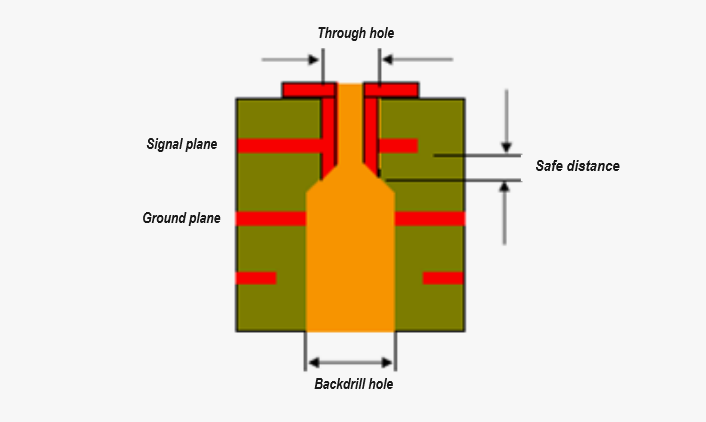Backdrilling is a technique used to remove through-hole stubs from the inner layers of multilayer PCB circuit boards.Its purpose is to drill out through-hole segments that do not serve any connecting or transmission purpose,avoiding reflections,scattering,delays,etc.,that can cause high-speed signal transmission.
Through-hole stubs are non-functional portions of plated through-holes or through-hole barrels that can cause unwanted reflections leading to signal distortion and performance degradation. By eliminating through-hole stubs, back drilling ensures consistent impedance alignment throughout the signal path, minimizing signal reflections and improving signal quality. If your design includes high-speed communication systems or sensitive analog circuits, back drilling is a good technique to meet performance requirements.
Plated-through holes can be considered part of the circuitry during the PCB manufacturing process. Some plated-through holes have no connection at the end, which can lead to signal foldback resonance. This can cause problems with reflections, scattering, and delays, which can affect the integrity of the signal transmission. Removing these unwanted “stubs” by back drilling can effectively mitigate these problems and ensure the quality of signal transmission.
The backdrilling process involves using a CNC machine to drill through-hole stubs from the opposite side of the board. The diameter of the back-drilled hole should be slightly larger than the diameter of the through-hole, typically about 4-6 mils larger, depending on the through-hole size and board thickness. This ensures that the hole removes the through-hole stub but does not damage the surrounding copper or dielectric layers.

Backdrilled holes utilize the depth control feature of a mechanical drill rig to drill NPTH holes with certain depth requirements and copper plating of the holes using a larger diameter drill cutter. Common types of back-drilled holes are broken piles, stepped, and non-conductive.
Advantages of PCB back drilling?
(1) Reduce noise interference;
(2) Localized board thickness becomes smaller;
(3) Improve signal integrity;
(4) Reduce the use of buried blind holes, reducing the difficulty of PCB circuit board production.
Removing the excess copper posts reduces unnecessary signal coupling paths, thus reducing noise interference. Without back drilling, the excess copper columns may interfere with the normal signal transmission of other signal lines, such as signals may produce abnormal electromagnetic induction and other phenomena in this excess part, resulting in the generation of noises. Back drilling removes some of the copper, resulting in a localized reduction in board thickness. Structurally, reducing the accumulation of unwanted materials, for multi-layer PCB board in the subsequent assembly, use of the process of better structural adaptability, such as more convenient to adapt to the internal structure of some of the equipment on the space constraints. When signals are transmitted through PCB layers, excess through-hole segments can cause reflections, scattering, and delays in the signal transmission process. Back-drilling removes these sections to make the signal transmission path cleaner and avoids these factors that affect signal integrity. For example, just like on a highway, if there are unwanted obstacles that can interfere with the smooth movement of a vehicle (representing the signal), back drilling is the process of removing these obstacles. Back drilling removes a portion of the copper, resulting in a localized reduction in board thickness. From the structural point of view, reducing the accumulation of unwanted materials, for multi-layer PCB board in the subsequent assembly, use of the process has better structural adaptability, such as more convenience to adapt to some of the space constraints on the internal structure of the equipment.
Although the existing backdrilling process has been automated control, in some parts of the manual intervention is still required. For example, the control of back drilling depth depends on monitoring the micro-current changes generated by the contact between the drilling needle and the plate surface during the drilling process, which is automated but may have certain errors. In the future, with the development of artificial intelligence and machine learning technology, the degree of automation of the back-drilling process is expected to be further improved, thereby reducing the influence of human factors and improving production efficiency and product quality.